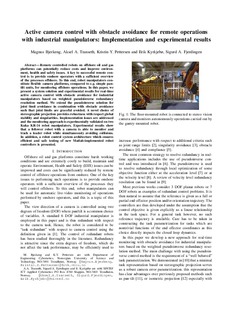Active camera control with obstacle avoidance for remote operations with industrial manipulators: Implementation and experimental results
Bjerkeng, Magnus; Transeth, Aksel Andreas; Pettersen, Kristin Ytterstad; Kyrkjebø, Erik; Fjerdingen, Sigrud Aksnes
Chapter, Peer reviewed
Accepted version
Permanent lenke
http://hdl.handle.net/11250/2448330Utgivelsesdato
2011Metadata
Vis full innførselSamlinger
Originalversjon
Active camera control with obstacle avoidance for remote operations with industrial manipulators: Implementation and experimental results. I: 2011 IEEE/RSJ International Conference on Intelligent Robots and Systems (IROS) : September 25-30, 2011. IEEE conference proceedings 2011 ISBN 9781612844541. s. 247-254 10.1109/IROS.2011.6094823Sammendrag
Remote controlled robots on offshore oil and gas platforms can potentially reduce costs and improve environment, health and safety issues. A key to successful remote control is to provide onshore operators with a sufficient overview of the processes offshore. To this end, robot manipulators constitute flexible camera platforms, compared to e.g. simple pan-tilt units, for monitoring offshore operations. In this paper, we present a system solution and experimental results for real-time active camera control with obstacle avoidance for industrial manipulators based on weighted pseudoinverse redundancy resolution method. We extend the pseudoinverse solution for joint limit avoidance in combination with obstacle avoidance such that joint limits are gracefully avoided. A novel choice of stereographic projection provides robustness with respect to global stability and singularities. Implementation issues are addressed and the monitoring approach is experimentally validated on two Kuka KR-16 robot manipulators. Experimental results show that a follower robot with a camera is able to monitor and track a leader robot while simultaneously avoiding collisions. In addition, a robot control system architecture which ensures efficient and safe testing of new Matlab-implemented robot controllers is presented.
